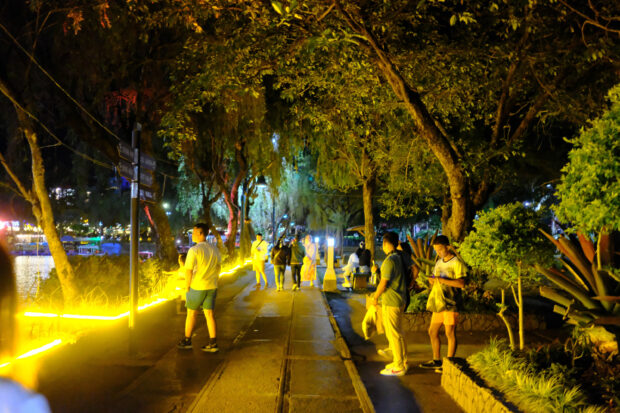Baguio seeks to address ‘local irritability’ as tourist influx continues

NIGHT PROMENADE | Tourists flock to Baguio City’s Burnham Park even at night to take advantage of its cool weather, shown in this photo taken on Jan. 14, 2024. (Photo by NEIL CLARK ONGCHANGCO / Inquirer Northern Luzon)
BAGUIO CITY, Benguet, Philippines — The resources used by tourists each time they visit this city are now being measured to help manage Baguio road space, water, and the environment and address local antagonism toward tourism, according to local officials.
Mayor Benjamin Magalong acknowledged that road gridlocks and heavy crowds, particularly during weekends, have contributed to rising “local irritability.”
Speaking at a tourism congress here on Jan. 12, Magalong said: “I wish I could simply go down to [the lowland provinces] and advise them [tourists] not to drive up in their cars, but I can’t do that.”
The planning congress discussed fresh ideas for a new tourism code as the industry prepares for this year’s Baguio Flower Festival, which starts on Feb. 1.
Also called Panagbenga, the festival has been the city’s biggest crowd drawer since its introduction in 1995, running second to the Yuletide season, Baguio’s peak tourism season.
Part of the city government’s tourism strategy is to understand and resolve why residents have started to resent tourism, which makes up a fourth of the city’s economy, said Donna Rimando Tabangin, the city planning, development, and sustainability officer.
“This irritation will affect tourism,” said Tabangin, noting that the city must strike a balance between improving the quality of life in the city and sustaining economic growth.
Baguio is undergoing redevelopment guided by two urban carrying capacity studies commissioned by the National Economic and Development Authority and the Department of Environment and Natural Resources.
According to these studies, many resources in the city, like its forest cover, open spaces, and water, are no longer sufficient for the local population and its transients.
Most redevelopment projects intend to prevent urban decay by 2045 if nothing is done to rehabilitate Baguio’s public resources.
Limitations
Residents, who “may have assumed that we have been improving Baguio for the tourists,” have to be assured that ongoing and future Baguio projects are designed for people living in the city, and not its frequent guests, Tabangin said.
She said tourism-oriented businesses must also incorporate the city’s inherent limitations in their business plans and operations, noting that based on its current demographics, Baguio’s population growth rate has accelerated by 1.25 percent.
The city’s nighttime population (people who live here) in 2023 was estimated at 380,269. Its daytime population, however, shot up to an average of 600,000 last year with the morning influx of tourists and workers, businessmen, and transient students who reside outside Baguio.
Following the trend, Baguio’s actual population would pass the 500,000 mark by 2046, reach 600,000 by 2060, and double to 734,560 by 2076.
Last year, the projected tourism arrivals were 1.042 million on top of the 380,209 population, Tabangin said, stressing that this meant an increased requirement for 761 additional police officers and an additional requirement of 20.82 million cubic meters (cu m) of water, equivalent to 0.15 cu m. needed by an individual per day in 2023. Tourists, on average, spend three days in the city.
Last year, tourists required the extra 269 million kilowatt hours (about 1.97 kWh per individual visitor per day) and produced 55,519.27 metric tons of rubbish (which cost the city P2,035.34 per MT of solid waste that needed to be disposed of). Guests also expelled 17,112.105 cu m of liquid waste.
Tabangin projected the additional demand for resources to increase further by 2029 when the city population has shot up to 409,685 and as many as 1.5 million tourists would have visited Baguio, dubbed as the country’s summer capital due to its cool weather.
That meant Baguio would need 819 more police officers—the additional 22.43 million cu m of water, 290.55 million kWh of electricity, P3.6 million to dispose of 59,815 MT of tourist trash, and process 18,436 cu m of liquid waste.
Liveable communities
Big-ticket projects now being developed by public-private partnership deals would regulate and improve traffic management and build environmentally safe transport and power systems. But the city aims to convert all neighborhoods into “liveable communities,” each equipped with its own small markets, pharmacies, hardware stores, and medical facilities, Tabangin said.
Revitalizing Baguio’s environment is key to improving tourism, according to Dr. Monina Buccat and Dr. Ramon Benedicto Alampay, professors at the University of the Philippines Asian Institute of Tourism.
Buccat highlighted the 2023 Asian Development Bank climate change assessment of Baguio, which is projected to suffer a 15-percent increase in annual rainfall, and “intensified extreme rainfall will generate more intense and frequent floods and landslides over 2031-2060.”
Both Buccat and Tabangin also addressed Baguio’s warming climate due to the heat island effect (when high concentrations of people and structures increase, the temperature within their vicinity increases). Tabangin stressed that Baguio’s brand attraction has been its cool weather.